Horn of Africa
| Horn of Africa | |
|---|---|
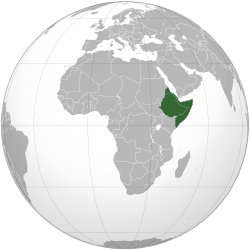 | |
| Countries |
1 unrecognised state |
| Population | 140,683,144 (2020 est.) |
| Area | 1,882,757 km2 |
The Horn of Africa (HoA), also known as the Somali Peninsula,[2][3][4] is a large peninsula and geopolitical region in East Africa.[5] Located on the easternmost part of the African mainland, it is the fourth largest peninsula in the world. It is composed of Somalia, Djibouti, Ethiopia, Eritrea and Somaliland.[6] Although not common, broader definitions also include parts or all of Kenya and Sudan.[7][8][9] It has been described as a region of great geopolitical and strategic importance since it is situated along the southern boundary of the Red Sea, extending hundreds of kilometres into the Gulf of Aden, Guardafui Channel, and Indian Ocean, it also shares a maritime border with the Arabian Peninsula.[10][11][12][13]
Names
This peninsula has been known by various names.
Description
The Horn of Africa Region consists of the internationally recognized countries of Djibouti, Eritrea, Ethiopia, and Somalia.[15][16][20][21]
Geographically the protruding shape that resembles a "Horn" consists of the "Somali peninsula" and eastern part of Ethiopia. But the region encompasses also the rest of Ethiopia, Eritrea and Djibouti.[22][23][24][25] Broader definitions include Kenya and Sudan.[26] The term Greater Horn Region (GHR) can additionally include South Sudan and Uganda.[27] The term Greater Horn of Africa is sometimes used to be inclusive of neighbouring southeast African countries to distinguish the broader geopolitical definition of the Horn of Africa from narrower peninsular definitions.[19][28][29]

The name Horn of Africa is sometimes shortened to HoA. Quite commonly it is referred to simply as "the Horn", while inhabitants are sometimes colloquially termed Horn Africans.[18][19] Regional studies on the Horn of Africa are carried out in fields of Ethiopian studies and Somali studies. This peninsula has been known by various names. Ancient Greeks and Romans referred to it as Regio Aromatica or Regio Cinnamonifora due to the aromatic plants or as Regio Incognita owing to its uncharted territory.
History
Prehistory
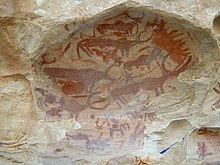
Some of the earliest
The findings of the Earliest Stone Tipped Projectiles from the Ethiopian Rift dated to more than 279,000 years ago "in combination with the existing archaeological, fossil and genetic evidence, isolate East Africa as a source of modern cultures and biology."[33][34][35]
According to the
Ethiopian and Eritrean agriculture established the earliest known use of the seed grass teff (Poa abyssinica) between 4000 and 1000 BCE.[37] Teff is used to make the flatbread injera/taita. Coffee also originated in Ethiopia and has since spread to become a worldwide beverage.[38]
Historian Christopher Ehret, cited genetic evidence which had identified the Horn of Africa as a source of a genetic marker "M35/215" Y-chromosome lineage for a significant population component which moved north from that region into Egypt and the Levant. Ehret argued that this genetic distribution paralleled the spread of the Afrasian language family with the movement of people from the Horn of Africa into Egypt and added a new demic component to the existing population of Egypt 17,000 years ago.[39]
Ancient history
The area comprising Somalia, Djibouti, the Red Sea coast of Eritrea and Sudan is considered the most likely location of the land known to the ancient Egyptians as Punt (or "Ta Netjeru", meaning god's land), whose first mention dates to the 25th century BCE.[40]
The
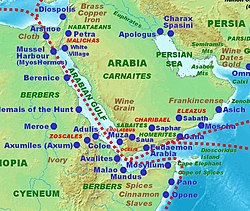
Somalia was an important link in the Horn, connecting the region's commerce with the rest of the ancient world. Somali sailors and merchants were the main suppliers of
The
Middle Ages and Early Modern era

During the Middle Ages, several powerful empires dominated the regional trade in the Horn, including the Adal Sultanate, the Ajuran Sultanate, the Ethiopian Empire, the Zagwe dynasty, and the Sultanate of the Geledi.
The
The
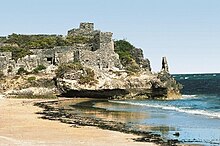
Through a strong centralized administration and an aggressive military stance towards invaders, the
The Zagwe dynasty ruled many parts of modern Ethiopia and Eritrea from approximately 1137 to 1270. The name of the dynasty comes from the Cushitic-speaking Agaw people of northern Ethiopia. From 1270 onwards for many centuries, the Solomonic dynasty ruled the Ethiopian Empire.
In 1270, the
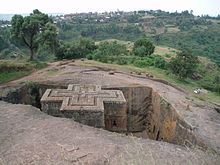
In the early 15th century, Ethiopia sought to make diplomatic contact with European kingdoms for the first time since Aksumite times. A letter from King
The first continuous relations with a European country began in 1508 with Portugal under Emperor
When Emperor
During the end of 18th and the beginning of 19th century the Yejju dynasty (more specifically, the Warasek) ruled north Ethiopia changing the official language of Amhara people to Afaan Oromo, including inside the court of Gondar which was capital of the empire. Founded by

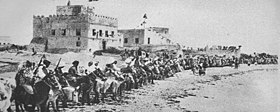
The
The Isaaq Sultanate was a Somali kingdom that ruled parts of the Horn of Africa during the 18th and 19th centuries. It spanned the territories of the Isaaq clan, descendants of the Banu Hashim clan,[62] in modern-day Somaliland and Ethiopia. The sultanate was governed by the Reer Guled branch of the Eidagale sub-clan established by the first sultan, Sultan Guled Abdi. The sultanate is the pre-colonial predecessor to the modern Somaliland.[63][64][65]
According to oral tradition, prior to the Guled dynasty the Isaaq clan-family were ruled by a dynasty of the Tolje'lo branch starting from, descendants of Ahmed nicknamed Tol Je'lo, the eldest son of Sheikh Ishaaq's Harari wife. There were eight Tolje'lo rulers in total, starting with Boqor Harun (Somali: Boqor Haaruun) who ruled the Isaaq Sultanate for centuries starting from the 13th century.[66][67] The last Tolje'lo ruler Garad Dhuh Barar (Somali: Dhuux Baraar) was overthrown by a coalition of Isaaq clans. The once strong Tolje'lo clan were scattered and took refuge amongst the Habr Awal with whom they still mostly live.[68][69]
The
The Sultanate of Hobyo was a 19th-century Somali kingdom founded by Sultan Yusuf Ali Kenadid. Initially, Kenadid's goal was to seize control of the neighboring Majeerteen Sultanate, which was then ruled by his cousin Boqor Osman Mahamuud. However, he was unsuccessful in this endeavor, and was eventually forced into exile in Yemen. A decade later, in the 1870s, Kenadid returned from the Arabian Peninsula with a band of Hadhrami musketeers and a group of devoted lieutenants. With their assistance, he managed to establish the kingdom of Hobyo, which would rule much of northern and central Somalia during the early modern period.[73]
Modern history
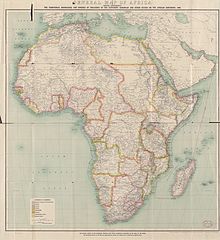

In the period following the opening of the
The strategic importance of Eritrea, due to its
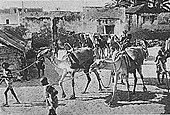
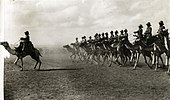
From 1862 until 1894, the land to the north of the
In 1958, on the eve of neighboring
The
Due to its longstanding ties with the
Modern Ethiopia and its current borders are a result of significant territorial reduction in the north and expansion in the east and south toward its present borders, owing to several migrations, commercial integration, treaties as well as conquests, particularly by
The early 20th century in Ethiopia was marked by the reign of Emperor
Haile Selassie's reign came to an end in 1974, when a Soviet-backed
, including around 15,000 Cuban combat troops.In 1989, the
Geography
Geology and climate
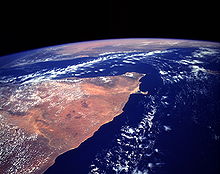
The Horn of Africa is almost
Geologically, the Horn and
Extensive glaciers once covered the Simien and Bale Mountains but melted at the beginning of the Holocene.[citation needed] The mountains descend in a huge escarpment to the Red Sea and more steadily to the Indian Ocean. Socotra is a small island in the Indian Ocean off the coast of Somalia. Its size is 3,600 km2 (1,400 sq mi) and it is a territory of Yemen.
The
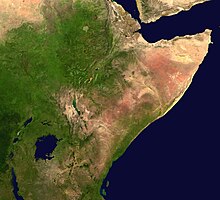
In the mountains of Ethiopia, many areas receive over 2,000 mm (79 in) per year, and even
The climate in Ethiopia varies considerably between regions. It is generally hotter in the lowlands and temperate on the plateau. At Addis Ababa, which ranges from 2,200 to 2,600 m (7,218 to 8,530 ft), maximum temperature is 26 °C (78.8 °F) and minimum 4 °C (39.2 °F). The weather is usually sunny and dry, but the short (belg) rains occur from February to April and the big (meher) rains from mid-June to mid-September. The Danakil Desert stretches across 100,000 km2 of arid terrain in northeast Ethiopia, southern Eritrea, and northwestern Djibouti. The area is known for its volcanoes and extreme heat, with daily temperatures over 45 °C and often surpassing 50 °C. It has a number of lakes formed by lava flows that dammed up several valleys. Among these are Lake Asale (116 m below sea level) and Lake Giuletti/Afrera (80 m below sea level), both of which possess cryptodepressions in the Danakil Depression. The Afrera contains many active volcanoes, including the Maraho, Dabbahu, Afdera and Erta Ale.[106][107]
In Somalia, there is not much seasonal variation in climate. Hot conditions prevail year-round along with periodic monsoon winds and irregular rainfall. Mean daily maximum temperatures range from 28 to 43 °C (82 to 109 °F), except at higher elevations along the eastern seaboard, where the effects of a cold offshore current can be felt. Somalia has only two permanent rivers, the Jubba and the Shabele, both of which begin in the Ethiopian Highlands.[108]
Ecology
About 220
Some important bird species of the Horn are the black boubou, the golden-winged grosbeak, the Warsangli linnet, and the Djibouti spurfowl.
The Horn of Africa holds more
There are about 100 species of

It is estimated that about 5,000 species of
Due to the Horn of Africa's
As of 2023, the Horn of Africa is affected by a severe
Demographics, ethnicity and languages

Besides sharing similar geographic endowments, the countries of the Horn of Africa are, for the most part, linguistically and ethnically linked together,
According to
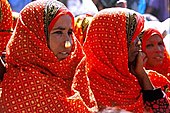
Languages belonging to the
idioms spoken in parts of southern Eritrea.Languages belonging to the
The Horn has produced numerous indigenous writing systems. Among these is
Economy
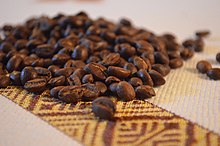
According to the IMF, in 2010 the Horn of Africa region had a total GDP (PPP) of $106.224 billion and nominal of $35.819 billion. Per capita, the GDP in 2010 was $1061 (PPP) and $358 (nominal).[123][124][125][126]
Over 95% of cross-border trade within the region is unofficial and undocumented, carried out by pastoralists trading livestock.[127] The unofficial trade of live cattle, camels, sheep and goats from Ethiopia sold to other countries in the Horn and the wider Eastern Africa region, including Somalia and Djibouti, generates an estimated total value of between US$250 and US$300 million annually (100 times more than the official figure), with the towns of Burao and Yirowe in Somaliland being home to the largest livestock markets in the Horn of Africa, with as many as 10,000 heads of sheep and goats sold daily from all over the Horn of Africa, with many of whom shipped to Gulf states via the port of Berbera.[127][128][129][130] This trade helps lower food prices, increase food security, relieve border tensions and promote regional integration.[127] However, the unregulated and undocumented nature of this trade runs risks, such as allowing disease to spread more easily across national borders. Furthermore, governments are unhappy with lost tax revenue and foreign exchange revenues.[127]
See also
- Incense trade route
- List of peninsulas
- Operation Enduring Freedom – Horn of Africa
- Silk Road
- Sub-Saharan Africa
- African Great Lakes Region
Notes
References
- ^ Encyclopædia Britannica, inc, Jacob E. Safra, The New Encyclopædia Britannica, (Encyclopædia Britannica: 2002), p.61: "The northern mountainous area, known as the Horn of Africa, comprises Djibouti, Ethiopia, Eritrea, and Somalia."
- ISBN 978-0-8160-7229-3.
This area is also known as the Somali Peninsula, because within it lies the countries of Somalia and eastern Ethiopia.
- ^ "Rethinking Pastoralism and African Development: a case study of the Horn of Africa" (PDF). October 2005. Archived from the original (PDF) on 26 March 2022. Retrieved 13 December 2021.
The Horn of Africa (or, Somali Peninsula) is a peninsula of Eastern Africa.
- ISBN 978-1-317-97544-1.
- ^ Robert Stock, Africa South of the Sahara, Second Edition: A Geographical Interpretation, (The Guilford Press; 2004), p. 26
- ^ "The Horn of Africa - Its Strategic Importance for Europe, the Gulf States, and Beyond". CIRSD. Retrieved 22 January 2024.
- ^ John I. Saeed, Somali – Volume 10 of London Oriental and African language library, (J. Benjamins: 1999), p. 250.
- ^ Sandra Fullerton Joireman, Institutional Change in the Horn of Africa, (Universal-Publishers: 1997), p.1: "The Horn of Africa encompasses the countries of Ethiopia, Eritrea, Djibouti, and Somalia. These countries share similar peoples, languages, and geographical endowments."
- Encyclopædia Britannica Online. Chicago, Illinois: Encyclopædia Britannica, Inc.Retrieved 4 April 2022.
- ^ "Three important oil trade chokepoints are located around the Arabian Peninsula - U.S. Energy Information Administration (EIA)". www.eia.gov. Retrieved 22 January 2024.
- ^ "Red Sea chokepoints are critical for international oil and natural gas flows - U.S. Energy Information Administration (EIA)". www.eia.gov. Retrieved 22 January 2024.
- ^ "Horn of Africa | Countries, Map, & Facts | Britannica". www.britannica.com. Archived from the original on 19 December 2021. Retrieved 19 December 2021.
- ^ "the Chairman of DPFZA and CEO of Red Sea Bunkering signed an investment with Afreximbank | DPFZA". dpfza.gov.dj. Retrieved 22 January 2024.
- ^ J. D. Fage, Roland Oliver, Roland Anthony Oliver, The Cambridge History of Africa, (Cambridge University Press: 1977), p.190
- ^ a b George Wynn Brereton Huntingford, Agatharchides, The Periplus of the Erythraean Sea: With Some Extracts from Agatharkhidēs "On the Erythraean Sea", (Hakluyt Society: 1980), p.83
- ^ a b John I. Saeed, Somali – Volume 10 of London Oriental and African language library, (J. Benjamins: 1999), p. 250.
- ^ Ciise, Jaamac Cumar. Taariikhdii daraawiishta iyo Sayid Maxamad Cabdille Xasan, 1895–1920. JC Ciise, 2005.
- ^ a b Teklehaimanot, Hailay Kidu. "A Mobile Based Tigrigna Language Learning Tool." International Journal of Interactive Mobile Technologies (iJIM) 9.2 (2015): 50–53.
- ^ ISBN 978-3-030-03721-5.
- ^ a b Sandra Fullerton Joireman, Institutional Change in the Horn of Africa, (Universal-Publishers: 1997), p.1: "The Horn of Africa encompasses the countries of Ethiopia, Eritrea, Djibouti, and Somalia. These countries share similar peoples, languages, and geographical endowments."
- ^ Felter, Claire (1 February 2018). "Somaliland: The Horn of Africa's Breakaway State". Council on Foreign Relations. Archived from the original on 21 November 2020. Retrieved 24 March 2021. It covers approximately two million square kilometers (770,000 square miles) and is inhabited by roughly 115 million people (Ethiopia: 110 million, Somalia: 15.8 million, Eritrea: 6.4 million, and Djibouti: 921.8 thousand).
- ^ Aweis A Ali (May 2021). "A Brief History of Judaism in the Somali Peninsula" – via ResearchGate.
- ^ "Horn of Africa". 4 June 2021. Archived from the original on 25 October 2022. Retrieved 13 August 2022.
- ^ "Britannica School". Archived from the original on 25 October 2022. Retrieved 13 August 2022.
- ^ Eliezer Wangulu (6 September 2007). "Somalia: Africa Insight – Why Talk in Hotels Won't Yield Long Term Peace". The Nation. Nairobi. Archived from the original on 8 June 2008. Retrieved 25 August 2022 – via AllAfrica.
- Encyclopædia Britannica Online. Chicago, Illinois: Encyclopædia Britannica, Inc.Retrieved 4 April 2022.
- JSTOR 10.7722/j.ctt1x73f1. Archivedfrom the original on 10 December 2021. Retrieved 12 December 2021.
- ^ Schreck, Carl J., and Fredrick HM Semazzi. "Variability of the recent climate of eastern Africa." International Journal of Climatology 24.6 (2004): 681–701.
- ^ "Somalia | Election, President, News, Capital, & Economy | Britannica". Archived from the original on 22 January 2022. Retrieved 13 August 2022.
- JSTOR 10.7722/j.ctt1x73f1. Archivedfrom the original on 10 December 2021. Retrieved 12 December 2021.
- ^ "Horn of Africa (Somalia, Ethiopia, Kenya)". Archived from the original on 10 December 2021. Retrieved 12 December 2021.
- PMID 35022610.
- PMID 24236011.
- PMID 30653331.
- ISBN 978-0-19-100971-6.
- S2CID 4417823.
- ISBN 9780521098434. Retrieved 25 July 2013.
- ISBN 9780521384568– via Google Books.
- ISBN 978-0-691-24410-5.
- ^ Simson Najovits, Egypt, trunk of the tree, Volume 2, (Algora Publishing: 2004), p.258.
- ^ Pankhurst, Richard K.P. Addis Tribune, "Let's Look Across the Red Sea I", 17 January 2003 (archive.org mirror copy)
- ^ Phoenicia, pg. 199.
- ^ Rose, Jeanne, and John Hulburd, The Aromatherapy Book, p. 94.
- ^ Vine, Peter, Oman in History, p. 324.
- ^ David D. Laitin, Said S. Samatar, Somalia: Nation in Search of a State, (Westview Press: 1987), p. 15.
- ^ I.M. Lewis, A modern history of Somalia: nation and state in the Horn of Africa, 2nd edition, revised, illustrated, (Westview Press: 1988), p.20
- ^ Brons, Maria (2003), Society, Security, Sovereignty and the State in Somalia: From Statelessness to Statelessness?, p. 116.
- ^ Morgan, W. T. W. (1969), East Africa: Its Peoples and Resources, p. 18.
- ISBN 978-0-8214-4461-0.
- ^ Shaping of Somali Society pg 101
- ^ Horn and Crescent: Cultural Change and Traditional Islam on the East African Coast, 800–1900 (African Studies) by Pouwels, Randall L.. pg 15
- ISBN 9781555876722.
- ^ Hassen, Mohammed. Oromo of Ethiopia with special emphasis on the Gibe region (PDF). University of London. p. 22.
- ^ Ian Mortimer, The Fears of Henry IV (2007), p. 111
- ^ Beshah & Aregay (1964), pp. 13–14.
- ^ Beshah & Aregay (1964), p. 25.
- ^ Beshah & Aregay (1964), pp. 45–52.
- ^ Beshah & Aregay (1964), pp. 91, 97–104.
- ^ Beshah & Aregay (1964), p. 105.
- ^ van Donzel, Emeri, "Fasilädäs" in Siegbert Uhlig, ed., Encyclopaedia Aethiopica: D-Ha (Wiesbaden: Harrassowitz Verlag, 2005), p. 500.
- ^ Pankhurst, Richard, The Ethiopian Royal Chronicles, (London:Oxford University Press, 1967), pp. 139–43.
- ^ I. M. Lewis, A pastoral democracy: a study of pastoralism and politics among the Northern Somali of the Horn of Africa, (LIT Verlag Münster: 1999), p. 157.
- ^ "Taariikhda Beerta Suldaan Cabdilaahi ee Hargeysa | Somalidiasporanews.com". Archived from the original on 19 February 2021. Retrieved 9 January 2021.
- ^ Genealogies of the Somal. Eyre and Spottiswoode (London). 1896.
- ^ "Taariikhda Saldanada Reer Guuleed Ee Somaliland.Abwaan:Ibraahim-rashiid Cismaan Guure (aboor). | Togdheer News Network". Archived from the original on 11 January 2021. Retrieved 9 August 2021.
- ^ "Degmada Cusub Ee Dacarta Oo Loogu Wanqalay Munaasibad Kulmisay Madaxda Iyo Haldoorka Somaliland". Hubaal Media. 7 October 2017. Archived from the original on 11 August 2021. Retrieved 11 August 2021.
- ^ "Taariikhda Toljecle". www.tashiwanaag.com. Archived from the original on 9 August 2021. Retrieved 9 August 2021.
- ^ Taariikhda Boqortooyadii Axmed Sheikh Isaxaaq ee Toljecle 1787, archived from the original on 15 August 2021, retrieved 15 August 2021
- ^ NEW ISSUES IN REFUGEE RESEARCH Working Paper No. 65 Pastoral society and transnational refugees: population movements in Somaliland and eastern Ethiopia 1988 – 2000 Guido Ambroso, Table 1, pg.5
- ^ Horn of Africa, Volume 15, Issues 1–4, (Horn of Africa Journal: 1997), p.130.
- ^ Michigan State University. African Studies Center, Northeast African studies, Volumes 11–12, (Michigan State University Press: 1989), p.32.
- Africa: rivista trimestrale di studi e documentazione, Volume 56, (Edizioni africane: 2001), p.591.
- ^ Helen Chapin Metz, Somalia: a country study, (The Division: 1993), p.10.
- ISBN 978-0-932415-91-2. Archivedfrom the original on 16 February 2023. Retrieved 14 October 2015.
- ^ Regions of Eritrea Archived 12 August 2011 at the Wayback Machine (accessed 17 November 2009)
- ^ "Eritrea – The spreading revolution". Encyclopædia Britannica Article. Archived from the original on 12 October 2007. Retrieved 16 October 2007.
- ^ Eritrea orders Westerners in UN mission out in 10 days Archived 19 June 2008 at the Wayback Machine. International Herald Tribune. 7 December 2005
- ^ Raph Uwechue, Africa year book and who's who, (Africa Journal Ltd.: 1977), p.209.
- ^ Hugh Chisholm (ed.), The encyclopædia britannica: a dictionary of arts, sciences, literature and general information, Volume 25, (At the University press: 1911), p.383.
- ^ A Political Chronology of Africa, (Taylor & Francis), p.132.
- ^ a b c Barrington, Lowell, After Independence: Making and Protecting the Nation in Postcolonial and Postcommunist States, (University of Michigan Press: 2006), p.115
- ^ Shillington (2005), p. 360.
- ^ I.M. Lewis, The modern history of Somaliland: from nation to state, (Weidenfeld & Nicolson: 1965), p. 78
- ^ Thomas P. Ofcansky, Historical dictionary of Ethiopia, (The Scarecrow Press, Inc.: 2004), p.405
- ISBN 978-0-521-23833-5.
- ^ Greystone Press Staff, The Illustrated Library of The World and Its Peoples: Africa, North and East, (Greystone Press: 1967), p.338.
- ^ Benjamin Frankel, The Cold War, 1945–1991: Leaders and other important figures in the Soviet Union, Eastern Europe, China, and the Third World, (Gale Research: 1992), p.306.
- ^ Oihe Yang, Africa South of the Sahara 2001, 30th Ed., (Taylor and Francis: 2000), p.1025.
- ^ Lacey, Marc (5 June 2006). "The Signs Say Somaliland, but the World Says Somalia". New York Times. Archived from the original on 27 June 2011. Retrieved 2 February 2010.
- World Factbook. Central Intelligence Agency. 14 May 2009. Archived from the originalon 12 June 2007. Retrieved 31 May 2009.
- ^ a b "Somalia: UN Envoy Says Inauguration of New Parliament in Somalia 'Historic Moment'". Forum on China-Africa Cooperation. 21 August 2012. Archived from the original on 14 October 2012. Retrieved 24 August 2012.
- ^ "Guidebook to the Somali Draft Provisional Constitution". Archived from the original on 20 January 2013. Retrieved 2 August 2012.
- ^ a b John Young. "Regionalism and Democracy in Ethiopia" Third World Quarterly, Vol. 19, No. 2 (June 1998) pp. 192
- ^ the people subjugated and incorporated were the Oromo, Sidama, Gurage, Wolayta and other groups. International Crisis Group. "Ethiopia: Ethnic Federalism and its Discontents" Africa Report No. 153, (4 September 2009) pp. 2
- ^ Great Britain and Ethiopia 1897–1910: Competition for Empire Edward C. Keefer, International Journal of African Studies Vol. 6 No. 3 (1973) page 470
- ^ Negash (2005), pp. 13–14.
- ^ a b Negash (2005), p. 14.
- ^ Negash (2005), p. 14, and ICG "Ethnic Federalism and its Discontents" pp 2; Italy lost over 4.600 nationals in this battle.
- ^ Clapham, Christopher, "Ḫaylä Śəllase" in Siegbert von Uhlig, ed., Encyclopaedia Aethiopica: D-Ha (Wiesbaden:Harrassowitz Verlag, 2005), pp. 1062–3.
- ^ "Man of the Year". TIME. 6 January 1936. Archived from the original on 30 July 2009. Retrieved 16 March 2009.
- ^ Clapham, "Ḫaylä Śəllase", Encyclopaedia Aethiopica, p. 1063.
- ISBN 978-3-8258-9535-8.
- ^ "Core Principles of Ethiopia's Foreign Policy: Ethiopia-Yemen relations". Ethioembassy.org.uk. Archived from the original on 10 May 2013. Retrieved 25 July 2013.
- ^ "2007 Annual Report" (PDF). Range Resources. Archived from the original (PDF) on 21 March 2012. Retrieved 14 July 2012.
- ^ "Oil and Gas Exploration and Production – Playing a Better Hand" (PDF). Range Resources. Archived from the original (PDF) on 17 October 2012. Retrieved 14 July 2012.
- ISBN 978-1552976692. Retrieved 17 September 2014.
- ISBN 978-1438126760. Archivedfrom the original on 15 March 2023. Retrieved 17 September 2014.
- ^ Hadden, Robert Lee. 2007. "The Geology of Somalia: A Selected Bibliography of Somalian Geology, Geography and Earth Science." Engineer Research and Development Laboratories, Topographic Engineering Center
- ^ [email protected] (31 January 2009). "Painted Hunting Dog: Lycaon pictus, GlobalTwitcher.com, ed. N. Stromberg". Globaltwitcher.auderis.se. Archived from the original on 9 December 2010. Retrieved 25 July 2013.
- ^ Sara Pantuliano and Sara Pavanello (2009) Taking drought into account Addressing chronic vulnerability among pastoralists in the Horn of Africa Archived 7 March 2012 at the Wayback Machine Overseas Development Institute
- ^ "22 million people at risk of hunger in horn of Africa due to drought". Africanews. 31 January 2023. Archived from the original on 23 February 2023. Retrieved 23 February 2023.
- ^ "Horn of Africa. Death grip" (in Italian). L'Osservatore Romano. 17 January 2023. Archived from the original on 23 February 2023. Retrieved 23 February 2023.
- ISBN 978-0-85255-225-4.
- ^ "Languages – Summary by country". Ethnologue.com. 19 February 1999. Archived from the original on 19 July 2013. Retrieved 25 July 2013.
- ^ "Languages of Ethiopia". Ethnologue. SIL International. Archived from the original on 3 February 2013. Retrieved 9 February 2013.
- CSA. 13 July 2010. Archived from the originalon 14 November 2010. Retrieved 18 January 2013.
- ^ "Ethnologue – Mushungulu". Ethnologue.com. 19 February 1999. Archived from the original on 19 October 2012. Retrieved 25 July 2013.
- ISBN 978-0-313-31333-2.
- ^ Rodolfo Fattovich, "Akkälä Guzay" in Uhlig, Siegbert, ed. Encyclopaedia Aethiopica: A-C. Wiesbaden: Otto Harrassowitz KG, 2003, p. 169.
- ^ Ministry of Information and National Guidance, Somalia, The writing of the Somali language, (Ministry of Information and National Guidance: 1974), p.5
- ISBN 978-0195382075. Archivedfrom the original on 18 August 2020. Retrieved 9 February 2018.
- ISBN 978-1-84545-280-3.
- ^ "Report for Selected Countries and Subjects". Imf.org. 14 September 2006. Archived from the original on 14 November 2017. Retrieved 25 July 2013.
- ^ "Report for Selected Countries and Subjects". Imf.org. 14 September 2006. Archived from the original on 11 August 2020. Retrieved 25 July 2013.
- ^ "Report for Selected Countries and Subjects". Imf.org. 14 September 2006. Archived from the original on 1 March 2021. Retrieved 25 July 2013.
- ^ "The World Factbook". Cia.gov. Archived from the original on 12 June 2007. Retrieved 25 July 2013.
- ^ a b c d Pavanello, Sara 2010. [1] Archived 12 November 2010 at the Wayback Machine. London: Overseas Development Institute
- ^ Regulating the Livestock Economy of Somaliland. Academy for Peace and Development. 2002.
- ISBN 978-1-56902-228-3.
- ^ A Self-portrait of Somaliland: Rebuilding from the Ruins. Somaliland Centre for Peace and Development. 1999.
Sources
- Beshah, Girma; Aregay, Merid Wolde (1964). The Question of the Union of the Churches in Luso-Ethiopian Relations (1500–1632). Lisbon: Junta de Investigações do Ultramar and Centro de Estudos Históricos Ultramarinos.
- Cana, Frank Richardson (1911). . Encyclopædia Britannica. Vol. 25 (11th ed.). pp. 378–384.
- Negash, Tekeste (2005). Eritrea and Ethiopia: the Federal Experience. Uppsala, Sweden: Nordiska Afrikainstitutet.
- Shillington, Kevin (2005). Encyclopedia of African History. CRC Press.
External links
- History of the Horn of Africa
- Horn of Africa News Agency
- Horn of Africa Biodiversity Hotspot
- Horn of Africa Concerns from the Dean Peter Krogh Foreign Affairs Digital Archives
- Combined Joint Task Force – Horn of Africa official website
- Global Governance Institute Analysis on the Horn of Africa and the EU
